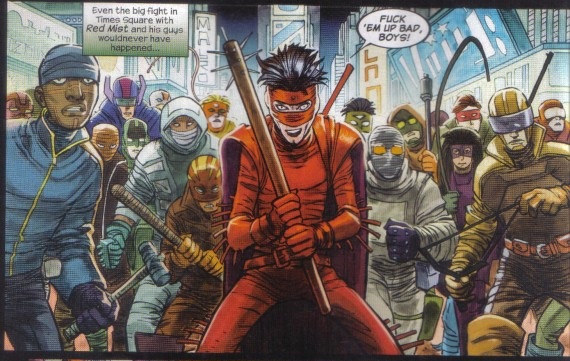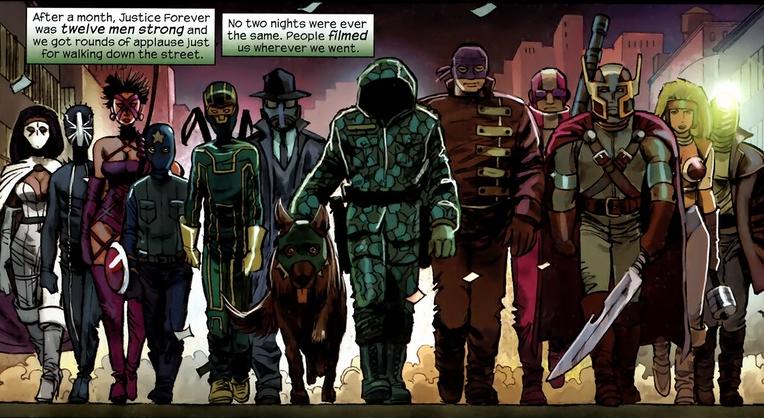While this series of articles regards flat scan would-be heroes in an at least quasi-realistic setting, Kick-Ass 2 in this context will be based on the comic. This is done because I have not been able to catch the movie version, and I do not believe the central themes to Kick-Ass 2 will change when it’s adapted for the silver screen.
AN ASIDE: KICK-ASS 2
In Theory
The realism of Kick-Ass as a movie is suspect, as it has been said. However, Kick-Ass 2 will inevitably rectify that in the sense that it touches upon a few things swept under the rug in the case of superhero stories.
The first is collateral damage. In a pure fantasy setting, collateral damage is shown mostly either to dramatic effect, or to make a point. Tall buildings fall, cars get tossed around, but what is often ignored is how much this flak catches actual, innocent civilians simply going their way prior to the outburst of action. What’s more, while villains target civilians as a way to get their point across, or “for the evuls,” they are almost always explicitly to get the attention of or get to the hero. Villains existing for total destruction are often regarded with spite even in the villain communities.
If we may return to Batman for a moment, there is often a question as to whether Batman responds to his rogues gallery of costumed, thematic villains, or creates them instead. A particularly good thesis on this was the animated series, “The Trial” where Batman is put to a trial in Arkham Asylum (with Joker as the judge and Two-Face as the prosecutor) with the charge that his brand of justice was what made the villains who they are now. The winning argument from Batman’s appointed attorney was that if it weren’t for Batman’s overall theme, they would still be criminals – simply without their antics.
© sneakpeek.ca
In Practice
The issue of an action-reaction relationship of masked figures’ existences is taken two-fold in Kick-Ass 2. First is the appearance of other, more costumed superheroes, including one of Dave’s friends. Their existence is largely due to the stand one scrawny kid took and managed to come out of on top – it is stated explicitly that Kick-Ass inspired others to do more to help the world be a better place. This has led to the formation of Justice Forever, a shout-out to the Justice League, that is basically a group of flatscan heroes gathered together to benefit from each other’s experiences and group solidarity.
Of course, heroes beget villains, and Red Mist, whom had become an internet troll at the end of Kick-Ass remakes himself as The Mother-Fucker, ruthless super villain. Using his father’s money, The Mother-Fucker puts together a brutally effective super villain group together, named, quite appropriately, The Toxic Mega-Cunts. Cut from a far more psychopathic cloth than Justice Forever, The Toxic Mega-Cunts, with the leadership The Mother-Fucker, begin to cut a swath through the city, all in the name of revenge for Frank D’Amico. While the group assembles under the flag of a villain who has it in for Kick-Ass, specifically, the rest of them are there for their own reasons, most definitely not just to get back at one particular flats can hero (e.g. Mother Russia, an ex-KGB agent, is there because she is being paid extremely well.)
It is here that the collateral damage begins to make itself apparent. The Mother-Fucker’s rampage aims precisely to create as much of this, and as unnecessarily cruelly as possible. For instance, when he targets Katie Deuxma, Kick-Ass’s crush, he doesn’t just take her and initiate a hostage scenario: he kills her parents, and gets his cohorts to take turns gang-raping her, leaving her traumatized. A further step results in the death of Dave’s father. The entire group of villains shows up at Dave’s father’s funeral, whereby they proceed to kill everyone present. Because of this focused, yet indiscriminate violence, the police begins to intervene, as while costumed heroes and villains were leading a war against one another, innocents were, invariably, getting caught in the crossfire.
© comicecke.de
It is established at the beginning of Kick-Ass 2, that the masked heroes of the city have a rapport with law enforcement that they are working in conjunction with the police as opposed to completely outside of them. However, The Mother-Fucker’s acts of violence make an already shaky partnership begin to collapse, as there is simply no way of distinguishing a hero from a villain on sight. This runs counter to why the costumes are donned, but makes a good point about the indiscriminate response of law enforcement to such matters. Law enforcement is based on the premise that the laws, while of course flexible, have to avoid discrimination between races, classes, genders, etc. But this incident in the comic (and the movie, it seems) also reaffirms the problem posed in the intro: that fringe benefits reaped from vigilantism is all that is keeping some of the heroes (those who can be brought down, the Rule of Cool making this impossible notwithstanding) at large.
It can be said that Kick-Ass, as a two-part series, is prone to its own brand of realism that takes into account small, yet prevalent details, yet, as a movie series, also often decides to challenge itself.
Next on “Superhero vs. Realism: The Ultimate Battle”
We will take a look at the James Gunn flick, “Super” to observe how, when a sense of realism is observed with a little more stability and more emphasis on a different breed of the flat scan hero, a theme that will endure for the remaining two parts: the mentally unsound one.






